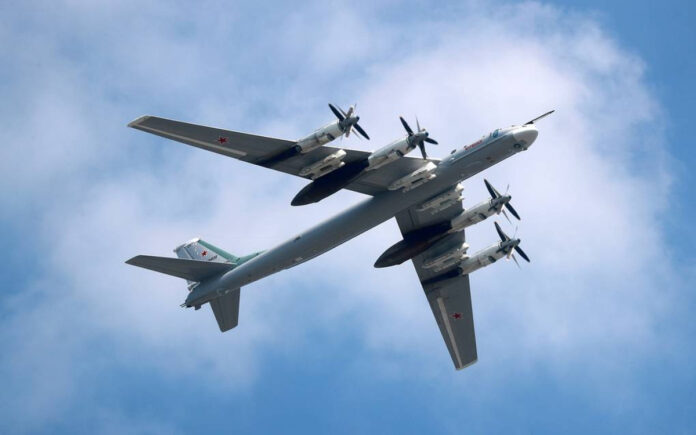Moscow: In response to Ukraine’s recent barrage of ATACMS missiles inside Russian territory, Moscow has turned to a long-standing military asset, the Tu-95 bomber, to intensify its assault on Ukraine. The Tu-95, a Soviet-era warplane, has been modified and repurposed into the Tu-95MSM strategic bomber, capable of firing long-range cruise missiles like the Kh-101 and its nuclear variant, the Kh-102.
Russia’s Counterstrike: Tu-95MSM Bombers Rain Down Kh-101 Missiles on Dnipro
Russia launched Kh-101 cruise missiles from the Tu-95MSM bombers targeting the Ukrainian city of Dnipro, as a direct response to Kyiv’s attacks. The bombers took off from Engels airfield in Russia, operating from strategic bases including Volgograd and Engels. These bombers have become an essential part of Moscow’s airstrike capabilities.
Tu-95MSM Features: A Relic of the Cold War Reborn for Modern Warfare
The Tu-95MSM, a re-engineered version of the Tu-95, has been in service for 72 years. The original Tu-95 first flew in 1952 during the Cold War, serving as the Soviet Union’s first intercontinental bomber. A total of 500 Tu-95 aircraft were built between 1952 and 1993, with the modern Tu-95MSM continuing to carry the legacy forward.
Despite its age, the Tu-95MSM remains a formidable warplane. It requires a crew of at least six, including a pilot, co-pilot, flight engineer, communication operator, and tail gunner, to manage its operations. The aircraft has a wingspan of 164.4 feet, is 151.7 feet long, and weighs approximately 90,000 kg, with a maximum takeoff weight of 188,000 kg. The Tu-95 can fly up to 15,000 km without needing to refuel, making it highly effective for intercontinental operations.
Equipped with four engines and eight contra-rotating propellers, the Tu-95MSM can reach a maximum speed of 925 km/h, typically cruising at around 700 km/h. It can also ascend rapidly, climbing 2,000 meters per minute to reach altitudes of up to 45,000 feet.
Tu-95MSM’s Offensive Capabilities: A Strategic Asset in Russia’s Arsenal
The Tu-95MSM is designed for heavy offensive operations, carrying up to 15,000 kg of munitions, including bombs and missiles. It can launch a variety of missiles, such as the Kh-20, Kh-22, Kh-55/101/102, or up to eight Kh-101/102 cruise missiles mounted under its wings. These weapons allow the aircraft to strike targets with devastating precision.
Also Read | Putin’s Hypersonic Missile Launch: A Major Escalation in the Ukraine War
In terms of self-defense, the Tu-95MSM is equipped with two 23 mm Gryazev-Shipunov GSS-23 autocannons at its tail, providing effective defense against enemy aircraft attempting to engage from behind. The tail gunner’s role is crucial in ensuring the bomber remains protected during its missions.
The Kh-101 Missiles: A New Era of Russian Precision Strikes
The Kh-101, a subsonic cruise missile, played a central role in Russia’s recent assault on Ukraine. Introduced in 2010, the Kh-101 has a range of 3,500 km and a maximum speed of 964 km/h. Measuring 24.5 feet in length and weighing 2,400 kg, the missile is capable of carrying conventional warheads. Its upgraded variant, the Kh-102, is designed to carry nuclear warheads, elevating the missile’s strategic value. The Kh-101 and Kh-102 missiles are deployed primarily via the Tu-95MSM and Tu-160 bombers.
Also Read | North Korea’s Kim Jong Un Accuses U.S. of Hostile Actions, Raises Nuclear Threat
As the Russia-Ukraine war continues, the Tu-95MSM bombers and Kh-101 missiles are integral components of Moscow’s offensive strategy, marking a new chapter in the ongoing conflict.



